八年级英语上册 8A Unit 4 Wild animals Welcome to the unit课件1 人教新目标版
8A Unit4 Wild animals教案

8A Unit4 Wild animalsReading执教者:高娟Teaching aims:1. Knowledge objectives:To read the passage about giant pandas and get the main ideas of the whole text.To get students to learn some words and phrases, get to know the growth ofgiant pandas, the problems giant pandas are facing and how to protect them. 2. Emotion objectives:To encourage the students to do as much as they can to help the wild animals.To activate the students' awareness of protecting wild animals and the nature. 3. Ability objectives:To improve students' ability of communication.To develop students' comprehensive language competence.Teaching aid: A multi-media computer, a tape recorderTeaching approach: Communicative ApproachTask-based Language ApproachCooperative Language Learning ApproachTeaching procedures:Step1. Revision1. T says: Yesterday we learned something about wild animals. Do youremember them?(Students answer: Yes.)2. T says: OK, now let's play a guessing game. Read the descriptions of theseanimals and tell us what wild animals they are.a). I come from Australia. I jump with my babies in my pocket. Who am I ?b). I am the biggest animal on land, I have a long nose and eat grass. Who amI ?c). I am small and have a big tail. I like climbing trees and eating nuts. Whoam I ?d). I am large and heavy. I have thick fur. I like eating sweet food and fish.Who am I ?e). I have yellow fur and black stripes. I look like a cat, but much bigger thana cat. Who am I ?f). I live in the sea. I am very friendly and clever. I can do lots of tricks inwater. Who am I ?g). I walk in the desert. Each eye of mine has three eyelids. Who am I ?h). I am a beautiful black and white animal. I look like a bear. I live only inChina . My greatest hope is to take a colour photo. Who am I? (When the students say out the answers, show the pictures on the screen.)Step2. Presentation1. Ask : Do you like wild animals? (Yes/ No.)Which is your favourite wild animal?Why do you like it/them?Students answer the questions.Teacher says: Do you know Miss Gao's favourite wild animal?--Giant pandas.I think they are very lovely. They are friendly to people and won't hurt people.Show a picture of a giant panda. Do you know anything about giant pandas?2.Teach new words by asking some questions about giant pandas.a). Where do giant pandas live?In the wild / In the forest/ In giant panda reserves..b). What do giant pandas eat?They eat bamboo shoots and leaves.3. Ask: But when a giant panda was born , can they eat bamboo shoots orleaves?(No.)What do they eat when they are at birth? And what are baby pandas like atbirth?Tsays: Today we have a chance to learn more about a giant panda.Step3. Fast-ReadingPlease read the passage as quickly as you can to find out the name of thegiant panda.Step4. Listening and scanningListen to the tape and then try to complete the chart.Age The growth of Xi Wang1 day weigh 100g10 days look like a white mouse4 months weigh 10kg, start to go outside her home6 months start to eat bamboo shoots and leaves8 months not a small baby any more,grow into a healthy young giantpanda,weigh 35kg20 months have to look after herselfRead the paragraphs1-3 and then let the Ss make the sentences with the words to introduce the growth of Xi Wang.Have a look at the pictures of the growth of Xi Wang and complete Part on Page61. Let the students introduce the growth of Xi Wang with their own words.Step5. Presentation1. Tsays: Do you think giant pandas are lovely? (Yes). But they are in danger. It'svery difficult for them to live in the wild. What problems are they facing?2. Listen to the tape and find out the problems they are facing. Problems ActionsIf hunters__________, they ___________. make giant panda reserves biggerIf farmers__________,giant pandas__________.build more reservesIf people___________, they ____________. encourage farmers to leave the giant panda reserves3. Let the students read the three paragraphs again and then say out the problems giant pandas are facing without looking at the books.4. Tsays: We have known the problems giant pandas are facing. Can we do something to help? OK, read the rest part of the passage and complete the chart above.5. Students say out the actions with their own words.Step6. Whole-readigRead the whole passage by themselves.Step7. An interviewLet one student stand in front of the class to act as Xi Wang. Others are all interviewers. Ask "Xi Wang"the questions they are interested in.Step8. DiscussionHold a further discussion: Why do we call it Xi Wang? Can you find another name for her?Step9. ClassworkFinish an exercise paper.。
肢体语言在8 A Unit 4 Welcome部分授课中的应用
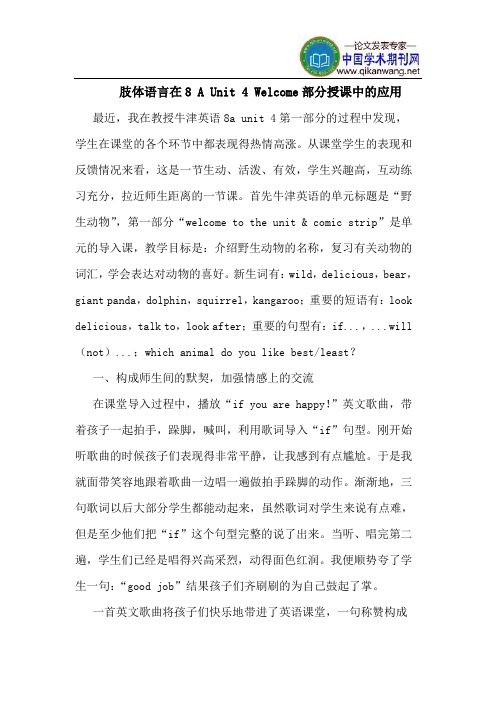
肢体语言在8 A Unit 4 Welcome部分授课中的应用最近,我在教授牛津英语8a unit 4第一部分的过程中发现,学生在课堂的各个环节中都表现得热情高涨。
从课堂学生的表现和反馈情况来看,这是一节生动、活泼、有效,学生兴趣高,互动练习充分,拉近师生距离的一节课。
首先牛津英语的单元标题是“野生动物”,第一部分“welcome to the unit & comic strip”是单元的导入课,教学目标是:介绍野生动物的名称,复习有关动物的词汇,学会表达对动物的喜好。
新生词有:wild,delicious,bear,giant panda,dolphin,squirrel,kangaroo;重要的短语有:look delicious,talk to,look after;重要的句型有:if...,...will (not)...;which animal do you like best/least?一、构成师生间的默契,加强情感上的交流在课堂导入过程中,播放“if you are happy!”英文歌曲,带着孩子一起拍手,跺脚,喊叫,利用歌词导入“if”句型。
刚开始听歌曲的时候孩子们表现得非常平静,让我感到有点尴尬。
于是我就面带笑容地跟着歌曲一边唱一遍做拍手跺脚的动作。
渐渐地,三句歌词以后大部分学生都能动起来,虽然歌词对学生来说有点难,但是至少他们把“if”这个句型完整的说了出来。
当听、唱完第二遍,学生们已经是唱得兴高采烈,动得面色红润。
我便顺势夸了学生一句:“good job”结果孩子们齐刷刷的为自己鼓起了掌。
一首英文歌曲将孩子们快乐地带进了英语课堂,一句称赞构成了师生间的默契,加强了情感上的交流。
老师微笑着说一声“good/excellent!”可能给惴惴不安的学生以极大的自信和鼓励,他们的劲头一下子来了,感到精神上的巨大欢愉。
二、将艺术美感、想象力和英语教学结合在一起在从comic strip到welcome的过渡过程中,运用了笔者自己的一张生活照。
8A Unit 4 Wild animals(Reading)
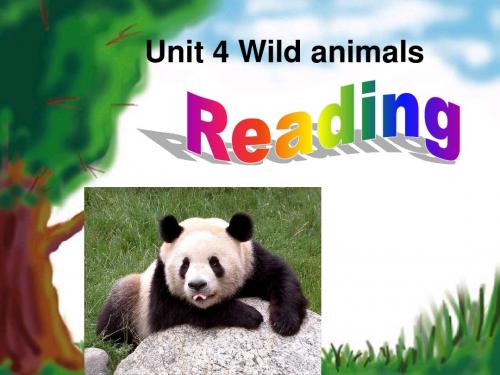
f
a
Suppose (假设)you are Xi Wang, say something about yourself, including(包括) your growth and problems you have.
at birth 100 grams
10 days Like a white mouse
What does it look like?
fur
thick
a baby panda
a giant panda
It looks like a bear, but with black and white fur.
grow into
It looks like a white mouse.
What does it eat ?
4 months 10 kg, go outside
6 months
12 months
20 months
Stop drinking…
Start to eat…
35kg, not…any more, grow into
Look after herself, because…
Why is Xi Wang crying?
It is the largest animal on land and its nose is very long.
elephant
It is small and lovely, but has a long tail. It likes nuts(坚果).
squirrel
Fill in the blanks. Foxes are clever and cunning. 1______ and eats insects, smaller animals. camel has three eyelids and can live without 2 A ______ water for a long time in the desert. tortoise can live up to 150 years old. 3 A _______ polar bear lives in the North Pole. It likes 4 A _______ eating fish. 5 Wolves _____ have very good eyesight,hearing and smell.
牛津英语8A Unit4 Welcome to the unit
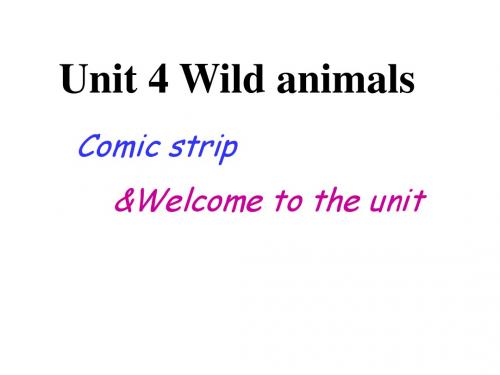
possible result result:
Eddie won’t talk to Hobo. Hobo will die. Eddie will die. No one will look after Hobo.
Differences bewteen pets and wild animals
Unit 4 Wild animals
Comic strip &Welcome to the unit
pet
An animal or a bird that you keep in your home and look after
1.What does Hobo want to do ?
He wants to share the delicious food with Eddie.
Wild animals are in danger!
• Tigers: People kill them for their fur,meat, even bones people cut down forests.
Wild animals are in danger!
• • • • giant pandas are in danger: low birth rates small habitat because of human arrow bamboo is beginning to die off. It happens every sixty years and the new crop will take around ten years to mature. bamboo bloomed was in the 1980s two hundred and fifty giant pandas dieful words
英语牛津译林八上Unit4教案(全单元教案)

英语牛津译林八上Unit 4:教案(全单元教案)《牛津初中英语》8A Unit 4 Wild animalsComic strip& Welcome to the unit一、教学目标1 了解对话内容,掌握重点词组及初步了解if句型的用法2. 熟悉学习更多有关野生动物的词语二、教学重难点学生讨论表达对动物的喜好三、教学流程Step1 Comic stripHobo and Eddie have a new problem now. Listen to the tape and answer the following questions.1 What does Hobo want to do?2 Is Eddie willing to share his food?Language points:look delicioustalk to/with sblook after/ take care ofAsk students to pay attention to‘if’clauses Step2 VocabulariesAsk students to look at the pictures and learn new words about wild animals.bear dolphin giant panda kangaroo squirrel tigerStep3 Guessing gamesLet students paly a guessing gane to engage them.One student describes and the other guess ‘What animal is it?’Step 4 Make a surveyAsk stuents to work in pairs. Complete the survey form on P59Step5 DiscussionA: Which animal do you like best?B: I like ……best.A: Why?B: Because they are …...A: Which animal do you like least?B: I like…… least.A: Why?B: Because they are …...Step 6 HomeworkRemember all the words about wild animals and try to describe them.《牛津初中英语》8A Unit 4 Wild animalsReading1一教学目标1.知识目标1.)知识并运用本课时的四会单词。
八年级英语上册-Unit-4《Wild-animals》复习课件-牛津译林版
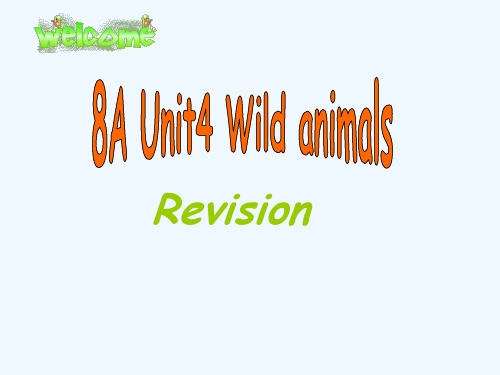
Unit 4
More examples
1. Some wild animals may die soon because they are losing homes 2. The wild animals can’t find enough food
18.用它们的骨头制成药
make medicine from their bones(看不出原材料)
19.用纸做成一个箱子
make a box out of paper (看出原材料)
20.以团队形式一起劳动 work as a team
21.以家庭形式生活
live as a family / live in family groups
2.courage(n) have (no) courage to do sth encourage (v) sb to do sth
3. lose (v) – lost-lost lose one’s way lose a game
lose one’s life adj: lost get /be lost
32.一份关于野生生物的报告
a report on wild animals
33.独自生活
live alone=live by oneself =live on one’s own
34.好的视力、听力和嗅觉
good eyesight, hearing and smell
35.由动物皮毛制成的衣服
clothes made of animal fur
because of the heavy snow.
3. Because wild animals are our friends on earth, we are trying our best to protect them when they are in danger.
牛津英语8AUnit 4 Wild animals学案
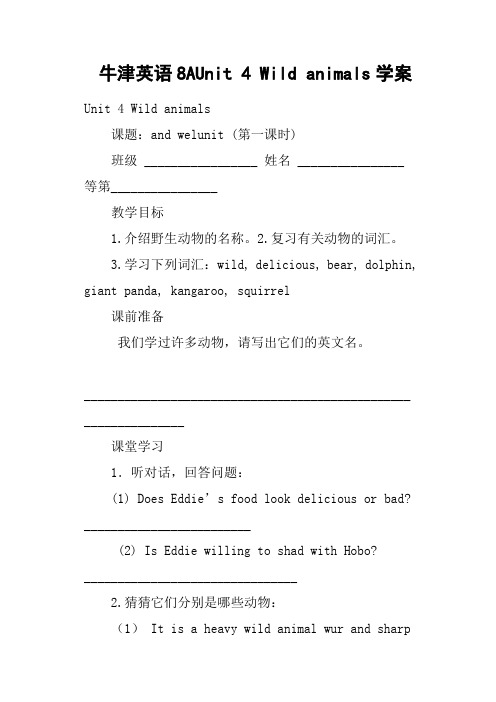
牛津英语8AUnit 4 Wild animals学案Unit 4 Wild animals课题:and welunit (第一课时)班级 _________________ 姓名 ________________ 等第________________教学目标1.介绍野生动物的名称。
2.复习有关动物的词汇。
3.学习下列词汇:wild, delicious, bear, dolphin, giant panda, kangaroo, squirrel课前准备我们学过许多动物,请写出它们的英文名。
_________________________________________________ _______________课堂学习1.听对话,回答问题:(1) Does Eddie’s food look delicious or bad? _________________________(2) Is Eddie willing to shad with Hobo?________________________________2.猜猜它们分别是哪些动物:(1) It is a heavy wild animal wur and sharpclaws. It can walk upward. (直立)(2) It jumps wbabu caAustralia. ______.(3) It liva. Its favoud is bamboo. _______ (4) It is a sea animal and looks like a largIt is very clever andlagauark. ______(5) Iganimal world. It has blabody. ______ (6) It is a small animal with a longail and red, grey or black fur. It eats nuts and liv______对话填空,一空一词。
八年级英语上册 Aunit4词组 牛津译林版
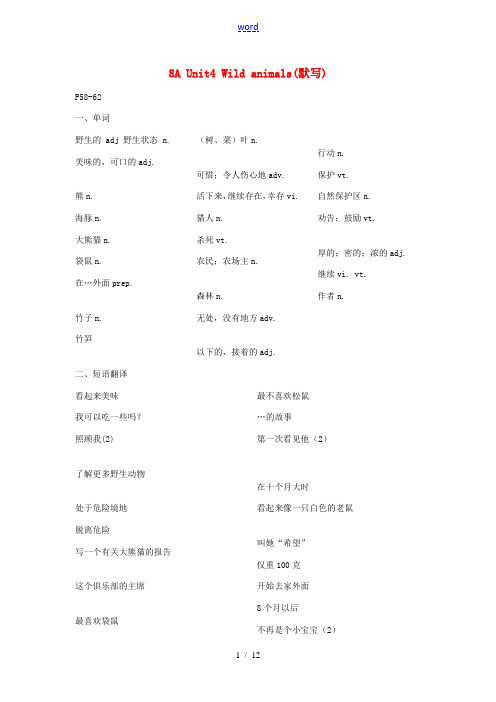
word8A Unit4 Wild animals(默写)P58-62 一、单词野生的 adj 野生状态 n. 美味的,可口的adj.熊n. 海豚n. 大熊猫n. 袋鼠n. 在…外面prep.竹子n. 竹笋 (树、菜)叶n.可惜;令人伤心地adv. 活下来,继续存在,幸存vi. 猎人n. 杀死vt.农民;农场主n.森林n. 无处,没有地方adv.以下的,接着的adj.行动n.保护vt.自然保护区n. 劝告;鼓励vt.厚的;密的;浓的adj.继续vi. vt. 作者n. 二、短语翻译 看起来美味我可以吃一些吗? 照顾我(2)了解更多野生动物处于危险境地 脱离危险 写一个有关大熊猫的报告这个俱乐部的主席最喜欢袋鼠最不喜欢松鼠…的故事 第一次看见他(2)在十个月大时 看起来像一只白色的老鼠叫她“希望” 仅重100克开始去家外面 8个月以后 不再是个小宝宝(2)长成一只健康的年轻大熊猫在一开始时喝她母亲的奶一天长达14个小时吃竹笋和竹叶不得不照顾她自己再生一个宝宝在野外生存由于人类一些她可能有的问题杀死它为了得到皮毛砍伐森林无处生存让她独自在家独自(3)/发现熊猫宝宝独自呆着将他们带走需要帮助在数学上需要帮助采取措施(2)保护他们采取以下的行动使得保护区更大建造更多的保护区鼓励/劝告某人做某事使某人安全不受威胁厚密的头发薄薄的冰支持我们大面积有树的陆地给野生动物居住的特别地区继续活着….的成长….的高度….的长度….的重量帮助他们生存需要待在野外给他看一份报告(2)在出生时三、翻译句子假如他吃了我的食物,我就不和他说话。
If he ________ ______,I _________ ______him.假如Lily不吃东西,她就会死。
If Lily ____________food, she ______________.假如她死了,没有人会照顾这些贫困地区的孩子了。
If she _________, ___________________________________in poor areas.我们需要帮助那些处于危险境地的野生动物们。
牛津译林版英语八上Unit 5《Wild animals》(Welcome)教学设计

牛津译林版英语八上Unit 5《Wild animals》(Welcome)教学设计一. 教材分析牛津译林版英语八上Unit 5的主题是“Wild animals”,本节课的主要内容是让学生掌握关于野生动物的词汇和表达方式,同时通过讨论和思考,提高学生对动物保护的意识。
教材中包含了丰富的图片、词汇和对话,为教学提供了很好的素材。
二. 学情分析学生在进入八年级时已经具备了一定的英语基础,能够进行简单的英语交流。
但是,对于一些较为复杂的野生动物的词汇和表达方式可能还比较陌生。
因此,在教学过程中,需要引导学生逐步掌握新词汇,并通过实际操作和练习,提高学生的语言运用能力。
三. 教学目标1.知识目标:让学生掌握关于野生动物的词汇和表达方式,了解动物保护的重要性。
2.能力目标:通过讨论和思考,提高学生对动物保护的意识,培养学生运用英语进行交流的能力。
3.情感目标:培养学生热爱大自然,关爱野生动物的情感。
四. 教学重难点1.重点:让学生掌握关于野生动物的词汇和表达方式。
2.难点:如何引导学生通过实际操作和练习,运用所学知识进行交流和讨论。
五. 教学方法1.任务型教学法:通过设定各种任务,让学生在实际操作中运用所学知识。
2.情境教学法:通过创设各种情境,让学生在真实的环境中学习和使用英语。
3.小组合作学习:通过小组讨论和交流,提高学生的参与度和合作能力。
六. 教学准备1.教学课件:制作包含野生动物图片、词汇和对话的教学课件。
2.教学材料:准备与野生动物相关的故事、文章等阅读材料。
3.教学设备:多媒体投影仪、音响设备等。
七. 教学过程1.导入(5分钟)利用多媒体展示一些野生动物的图片,引导学生谈论这些动物的特点和生活习性。
2.呈现(10分钟)通过课件展示本节课的主要词汇和表达方式,如:tiger, lion, panda, giraffe等,同时呈现相应的句子,让学生跟读并进行模仿。
3.操练(10分钟)将学生分成小组,每组选择一种野生动物,用英语介绍这种动物的特点和生活习性。
8A_Unit_4_Wild_animals
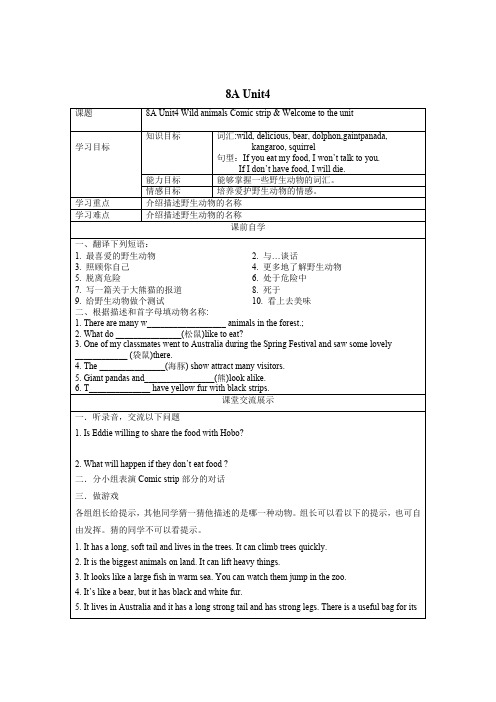
8A Unit4课题8A Unit4 Wild animals Comic strip & Welcome to the unit知识目标词汇:wild, delicious, bear, dolphon,gaintpanada,学习目标kangaroo, squirrel句型:If you eat my food, I won’t talk to you.If I don’t have food, I will die.能力目标能够掌握一些野生动物的词汇。
情感目标培养爱护野生动物的情感。
学习重点介绍描述野生动物的名称学习难点介绍描述野生动物的名称课前自学一、翻译下列短语:1. 最喜爱的野生动物2. 与…谈话3. 照顾你自己4. 更多地了解野生动物5. 脱离危险6. 处于危险中7. 写一篇关于大熊猫的报道8. 死于9. 给野生动物做个测试10. 看上去美味二、根据描述和首字母填动物名称:1. There are many w__________________ animals in the forest.;2. What do _______________(松鼠)like to eat?3. One of my classmates went to Australia during the Spring Festival and saw some lovely____________ (袋鼠)there.4. The _______________(海豚) show attract many visitors.5. Giant pandas and________________(熊)look alike.6. T______________ have yellow fur with black strips.课堂交流展示一.听录音,交流以下问题1. Is Eddie willing to share the food with Hobo?2. What will happen if they don’t eat food ?二.分小组表演Comic strip部分的对话三.做游戏各组组长给提示,其他同学猜一猜他描述的是哪一种动物。
《牛津初中英语》8A__Unit_4_Wild_animals教案新部编本(2)

精选教课教课设计设计| Excellent teaching plan教师学科教课设计[ 20–20学年度第__学期]任教课科: _____________任教年级: _____________任教老师: _____________xx市实验学校《牛津初中英》 8A Unit 4 Wild animalsComic strip& Welcome to the unit一、教课目1 认识内容,掌握要点及初步认识if 句型的用法2.熟习学更多相关野生物的二、教课重点学生表达物的爱好三、教课流程Step1 Comic stripHobo and Eddie have a new problem now. Listen to the tape and answer the following questions.1 What does Hobo want to do?2 Is Eddie willing to share his food?Language points:look delicioustalk to/with sblook after/ take care ofAsk students to pay attention to ‘ if ’ clausesStep2 VocabulariesAsk students to look at the pictures and learn new words about wild animals. bear dolphin giant panda kangaroo squirrel tigerStep3 Guessing gamesLet students paly a guessing gane to engage them.One student describes and th e other guess ‘ Whatanimal is it? ’Step 4 Make a surveyAsk stuents to work in pairs. Complete the survey form on P59Step5 DiscussionA:Which animal do you like best?B:I like ⋯⋯best.A:Why?B:Because they are ⋯ ...A:Which animal do you like least?B:I like ⋯⋯ least.A: Why?B:Because they are ⋯ ...Step 6 HomeworkRemember all the words about wild animals and try to describe them.《牛津初中英》 8A Unit 4 Wild animals Reading1 一教课目1.知目1.)知并运用本的四会。
8AUnit 4 Wild animals

Ok ,now ,let’s play a guessing game .I’ll describe them with some easy words ,you just need to guess what animals it is.
Consolidation
We can use conditional sentences to talk about possible situations.
Give you two more minutes to work in pairs .Then I will ask several pairsto act it out.
5dolphin; I live in water .i like swimming. I can do different kinds of swimming shows .Many people bring their children to watch my shows. They all think I am one of the cleverest animal8wx/pic/item/eabf047ba537b1c92f73b335.jpg
These animals have many other friends in the wild.
For example, monkeys .lions giraffes. camels. zebras. polar bears 8wx/pic/item/2a843bf6b996120081/2008122241240.jpg
Step3 .Working in pairs
8A英语教学设计与反思-Unit 4 Wild animals
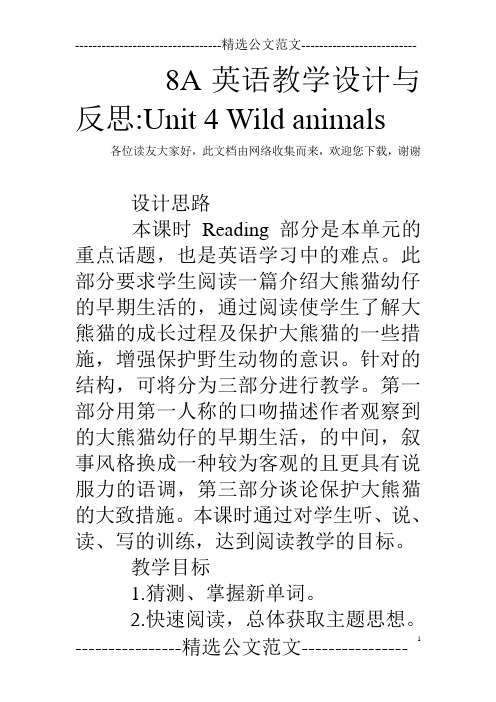
8A英语教学设计与反思:Unit 4 Wild animals 各位读友大家好,此文档由网络收集而来,欢迎您下载,谢谢设计思路本课时Reading部分是本单元的重点话题,也是英语学习中的难点。
此部分要求学生阅读一篇介绍大熊猫幼仔的早期生活的,通过阅读使学生了解大熊猫的成长过程及保护大熊猫的一些措施,增强保护野生动物的意识。
针对的结构,可将分为三部分进行教学。
第一部分用第一人称的口吻描述作者观察到的大熊猫幼仔的早期生活,的中间,叙事风格换成一种较为客观的且更具有说服力的语调,第三部分谈论保护大熊猫的大致措施。
本课时通过对学生听、说、读、写的训练,达到阅读教学的目标。
教学目标1.猜测、掌握新单词。
2.快速阅读,总体获取主题思想。
3.根据时间顺序,了解大熊猫的成长过程。
4.了解大熊猫的处境及保护大熊猫的一些措施。
5.增强保护野生动物的意识。
教学重点1.猜测、掌握新单词。
2.快速阅读,总体获取主题思想。
3.根据时间顺序,了解大熊猫的成长过程。
4.了解大熊猫的处境及保护大熊猫的一些措施。
教学难点1.快速阅读,总体获取主题思想。
2.根据时间顺序,了解大熊猫的成长过程。
3.了解大熊猫的处境及保护大熊猫的一些措施。
教学准备学生准备:预习Reading部分新单词;阅读,了解大意、结构;收集有关大熊猫的信息和图片;完成B、c部分练习。
教师准备:课堂教学设计案;教学挂图;有关本课时教学的幻灯片;学生讨论材料、课堂达标练习等。
教学过程Step1RevisionAsk:Doyoulikeanimals?whatanimalsdoyou likebest?Andwhichoneswouldyouliketohav easpets? Showsomepicturesofanimalsonpage55onth eslidesandhavetheclasssayouttheirnames.Step2lead-in Showsomepicturesofthepanda,askoyoulike it?Doyouwanttoknowsthmoreaboutit?Then saytodaylet’slearnaStoryofXingwang.Step3checkingcheckhomework..Step4PresentationTask1skimming:LetthXiwangisthenameofababygiantpanda. Babygiantpandasareverysmallwhentheywe reborn.Theygrowveryquickly.At3months,shewas10kilos. Xiwanghadtolookafterherselfwhenshewas1 0monthsold.Hunterskillgiantpandasandselltheirfur. Task2Listeningfortheinformationaboutthet ext.Gettheclas各位读友大家好,此文档由网络收集而来,欢迎您下载,谢谢。
- 1、下载文档前请自行甄别文档内容的完整性,平台不提供额外的编辑、内容补充、找答案等附加服务。
- 2、"仅部分预览"的文档,不可在线预览部分如存在完整性等问题,可反馈申请退款(可完整预览的文档不适用该条件!)。
- 3、如文档侵犯您的权益,请联系客服反馈,我们会尽快为您处理(人工客服工作时间:9:00-18:30)。
Exercise Fill in the blanks
1.你的食物看上去很美味. delicious Your food _________ _________. looks 2.如果你吃了我的东西,我就不和你说话. won’t If you ______ my food, I _______talk to you. eat 3.如果我死了,就没人照顾你了. will look If I _____, no one ______ ______ after you. die 4.你更喜欢哪一个动物,这只大熊猫还是那只小松鼠? animal Which_______ do you like better, this______ ________ or that small giant panda squirrel _________? 5.我再也不喜欢野生动物了. don’t wild any I_______ like _______ animals ____ _______. more
I like …best because… I like …least because…
Make a survey
bear Me Partner dolphin giant panda kangaroo squirrel tiger
New words
1.wile 3.bear
adj. 野生动物
kangaroo
Which animal likes eating nuts very much ?
squirrel
Which animals can sleep for several days without eating anything in winter ?
•
Snake \ bear \ frog
camel(s)
Which animal has a long neck ?
giraffe(s)
Which animal can live longer than human beings ?
tortoise
Which animal lives in Australia and has a pocket ?
dinosaur(s)
Which animal is the biggest one on earth ?
whale(s)
And which animal is the biggest on land ?
ቤተ መጻሕፍቲ ባይዱ
an elephant
Which animal can walk in the desert for a long time without water ?
Unit 4
Wild animals
How many kinds of animals are there in the world ?
There are about one million five hundred thousand . (1,500,000)
Which animal lived on earth long long ago ? And it also died long long ago ?
Which animal lives in China and likes eating bamboo shoots and leaves ?
panda(s)
•
Which animal is the most honest to its master ?
dog
•
Which animal(s) do you like best ? / least ? If possible , please give us some reasons .
•
No , they are very selfish.
Just like Hobo and Eddie ,listen to the tape , find out : what are Eddie’s answers when Hobo asks for his food?
“If you eat my food ,I won’t talk to you . “If I don’t have food ,I will die too . “If I die , no one will look after you .
These wild pandas are very _______(interst). The news sounds _______(excite),doesn’t it?
5.
6. 7. 8.
Mr’s Li mother is _______(bad) ill.
I like many wild animals, but I like squirrel _____(good. I like zebra very much because it is very _______(beauty) English is a bridge to so much _______(know).
adj. 可口的
n. 野生状态
2.delicious
n.
熊
n. 海豚
4.dolphin
5.giant panda
6.kangaroo
n. n.
n.
大熊猫
袋鼠 松鼠
7.squirrel
Do you think dogs are generous ? Are they willing . to share food with others ?
Listen again and repeat it !
词性。
1. Hello, how many ______(sheep) does your grandpa keep?
2.
3. 4.
Millie is sitting at the desk and _____(listen)to music.
